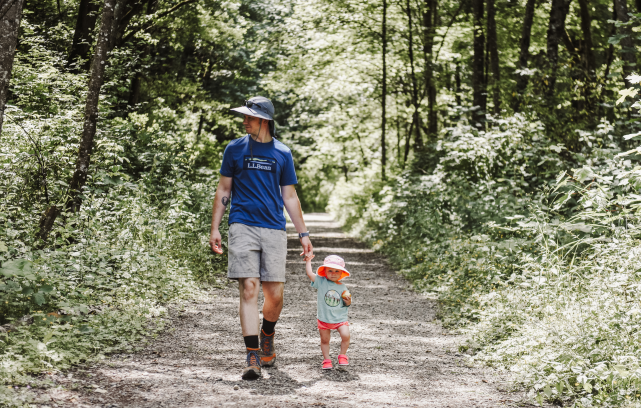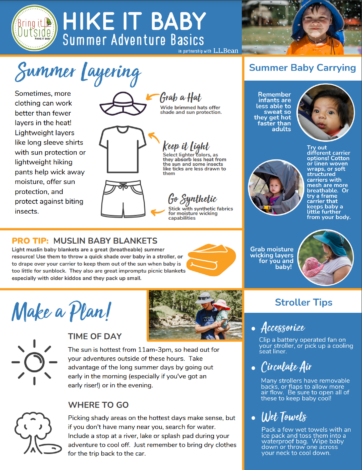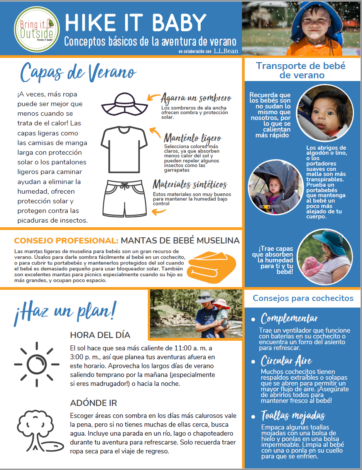Keeping Your Family Warm on the Trail this Winter
As we head into winter and have the added challenge of trying to stay warm, one of the most common questions we get is, “How do I dress my family for outdoor adventures in the cold, and what other gear do we need?” While the answer depends largely on where you live, we have compiled some helpful tips, gear suggestions and links to past blogs so that you have all the information you need for getting the most out of this winter in one convenient spot. "How do I dress my family for cold-weather outdoor adventures?" This is arguably one of the most asked questions throughout the year, and for good reason! So let’s break it down based on age, because dressing an infant for the cold is very different from dressing a grown adult.
Adults
No matter the age, layers are key.
Base layer: This is the layer closest to your skin. You may have heard the term “cotton is rotten,” which is never more true than picking a base layer for cold days in nature. Wool is generally best, but a synthetic blend of wicking material is a budget-friendly option as well. This layer comes in multiple varieties depending on temperature and activity level (heavyweight is the thickest for the most frigid weather conditions).
Mid-layer: This layer goes over your base layer and keeps you warm (think fleece sweatshirt). I prefer a full-zip option to assist with chilly nursing sessions.
3rd layer: This is optional based on outdoor temperatures and your planned activity. When temperatures are very low or wind/snow are a factor, you may consider an extra layer to ensure warmth. Just remember, it is easy to take off a layer if you get warm, but you can’t add a layer you don’t have!
Outer layer: Generally you will want a weather-resistant outer layer that can stand up to low temperatures along with possible precipitation and wind. How “weather-resistant” this layer needs to be will depend on the expected conditions. For example, if you are expecting rain or wet snow, you will definitely want a water-proof outer layer.
Head, hands and feet: When temperatures are low, our bodies focus on keeping most of our warmth in toward our core to keep us safe. While this is essential, it can certainly get uncomfortable for our extremities! That’s why good-quality hats, gloves/mittens, socks, scarves, etc., are important. As with our body layers, it is best to stick with wicking wool or synthetic materials here as well. Just remember, wet feet and hands will feel icy in low temperatures!
Footwear: Traction and warmth are key, especially if you are babywearing or hiking on wet or icy terrain. If you live in a location that sees snow and rain, you will want waterproofing as well. Other than that, the type of footwear is largely personal preference here. For example, I prefer ankle support so I have traditional waterproof winter hiking boots along with snow boots. In contrast, my husband prefers a more flexible fit, so he sticks with waterproof trail runners unless more extreme conditions force him into his snow boots.
Check out these past blog posts for more in-depth information on winter layering, all-weather hiking essentials, and winter gear tips.
“Big-Kids” (aka older toddlers and beyond)
Children who are good walkers will follow much the same rules as adults with a few tweaks for kiddos who like to get down and dirty in the snow and mud.
Full-coverage waterproofing: In order to stay warm, our kiddos need to stay dry. This isn’t always an easy task when snow or cold rain is involved. Consider either a waterproof winter coat and pants or a rain suit that can be used as a thin waterproof outer layer with multiple warm layers underneath.
Waterproof boots and mittens/gloves: While adults can usually get away with water-resistant options, kids have a tendency to get as wet and messy as possible, so waterproof options are worth the extra money here. Check out some great options we can recommend here.
For more information on dressing the whole family for outdoor winter adventures, check out this article.
Infants
Dressing an infant for the cold will rely heavily on whether they are going to be in a carrier the majority of the time, crawling in or exploring the snow, or tucked away in a stroller. In general, layers are key. As with adults and big kids, start with a wool or synthetic base layer. Fleece-footed pajamas work well for a mid-layer, and a down or fleece bunting outer layer will help keep them warm and toasty. Add a warm hat that covers the ears and goes under the chin along with adult wool socks over their hands under the bunting to ensure these areas stay warm and dry. Include a waterproof outer layer (such as a rain suit or waterproof bunting) if they will be rolling in the snow. For stroller walks, add a stroller weather-shield or a thick blanket for added warmth. Since infants are not great at regulating their own temperature, be sure to check for flushed skin, chilly extremities or irritability as signs that they may be too warm or cold. Find more information in these past blog posts on winter layering for infants and winter hiking with babies along with this past gear guide for more ideas on keeping your baby cozy in these colder months.
Babywearing to stay warm
Wearing a baby (especially with a wrap or a soft-structured carrier) can get HOT. For this reason, you will need to consider how you layer both yourself and baby. For adults, removing the mid-layer (aka the “warm” layer) can help prevent over-heating. If you want more information on cold-weather babywearing, check out these articles on winter layering when babywearing, and layering for all aspects of motherhood (pregnancy on up).
What Other Gear do I Need?
This will differ based on trail conditions and outdoor activity, but here are some options to consider in order to make your adventure as enjoyable (and comfortable) as possible.
Hiking essentials: Whether you are going on a family winter hike for a few hours or a longer snowshoeing adventure, be sure to pack the "10 Essentials" in a good-quality hiking pack. It’s a good idea to include some hand and foot warmers for those extra cold days! Read more about the 10 essentials and what you need for a successful day hike here.
Traction cleats or spikes: Cleats or spikes are especially important when babywearing on frozen or snow-covered ground. They are easy to attach to most shoes and boots and help prevent slipping and sliding on the trails.
Hiking poles: Hiking poles are another important gear option for added stability on icy or wet trails.
Snowshoes: If you live in an area that experiences plenty of snowfall in the winter months, snowshoes are a fun (and at times more practical) option for hiking. They make them in toddler-/kid-size as well! Check out this Family Snowshoeing 101 article for everything you need to know to get started with snowshoeing for the entire family.
Sled or snow tube: Who doesn’t love speeding down a snowy hill?
Winter camping gear: Are you ready to take the plunge and camp in the winter with your family? While it may sound crazy, there are actually various benefits to cold-weather camping, such as less crowding and prime campsite availability. Check out a few of our past blog posts for tips on layering for cold camping and picking the right camping gear to ensure an enjoyable experience for the whole family.
What winter gear do you find essential to ensure an enjoyable outdoor experience for your family? Let us know in the comments below!
Read more:
Winter hiking - How to layer for infants
How to layer when babywearing in the cold
5 Comfy and cozy winter carriers for babywearing
Photos by Laura Castro and Amy Diebold.
ABOUT OUTGROWN
OutGrown is a 501(c)(3) nonprofit that works to create a world where everyone can enjoy the physical and mental benefits of spending time outside. We are focused on creating opportunities and removing barriers to access so families with babies and young children can take their first steps outside. We believe all families have the right to connect with nature, benefit from spending time outdoors and be inspired to a lifelong love of nature. Since its grassroots inception in 2013, OutGrown is a growing community of 280,000 families and over 300 volunteer Branch Ambassadors. More information on all of our programs can be found at WeAreOutGrown.org
EDITORS NOTE:
We hope you enjoyed reading this article from OutGrown. We’re working hard to provide our community with content and resources that inform, inspire, and entertain you.
But content is not free. It’s built on the hard work and dedication of writers, editors, and volunteers. We make an investment in developing premium content to make it easier for families with young children to connect with nature and each other. We do not ask this lightly, but if you can, please make a contribution and help us extend our reach









Comments